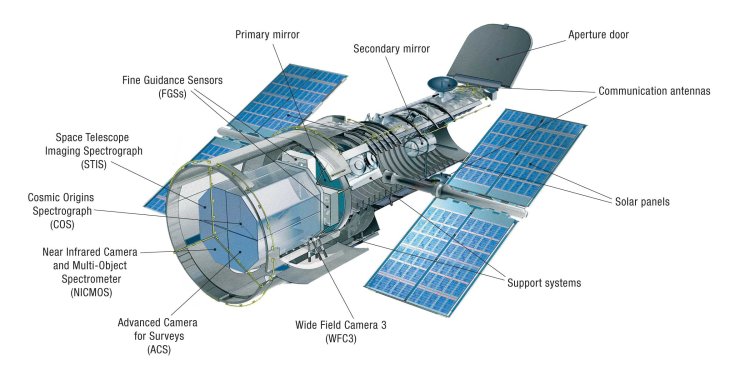The Hubble Space Telescope generates about 480 GB of data every month as it performs observations. Throughout its existence it has been able to “reach” celestial bodies that cannot be seen from the surface of the Earth. More than 1 million pictures of stars, nebulae and galaxies have already been received. And how many it will have its sight on, no one really knows.
The Hubble Space Telescope is an automatic observatory orbiting the Earth, a joint project between NASA and the European Space Agency. It is counted among NASA's Great Observatories.
The telescope launched into space is capable of recording electromagnetic radiation in frequencies that are shielded by the Earth’s atmosphere (including the infrared range). Hubble is free of the atmosphere; thus, its resolution is 7 to 10 times greater than that of its “terrestrial” counterparts.
The space device was named after Edwin Hubble, an astronomer and cosmologist. The scientist confirmed the existence of other galaxies, developed a theory of expanding Universe. A scientific law and a magnitude are named in honor of him.
The idea of launching an orbital telescope was mulled over long before Hubble. It was obvious that there would be many advantages. They were proved by Lyman Spitzer in his 1946 paper, Astronomical Advantages of an Extra-Terrestrial Observatory.
- First, the only factor limiting its angular resolution would be diffraction, not turbulent flows in the atmosphere (resolutions of terrestrial telescopes range from 0.5 to 1.0 angular second while the theoretical limit of diffraction resolution for an orbital telescope with a mirror of 2.5 meters in diameter is about 0.1 second).
- Second, the space telescope could perform observations in infrared and ultraviolet bands where a significant fraction of radiation is absorbed by the Earth’s atmosphere.
In 1962, a report published by the U.S. National Academy of Sciences recommended incorporation of an orbital telescope development into the space program. Three years later, Spitzer headed a committee tasked with identifying scientific objectives for a large space telescope.
Multiple companies worked on the design:
The Marshall Center contracted Perkin-Elmer to design and manufacture the Optical Telescope Assembly (OTA) and precise guidance sensors. The Lockheed Corporation was awarded a contract to build a spacecraft for the telescope.
A total $2.5 billion was spent from design start to launch even though the initial budget was $400 million. Total project costs were estimated in 1999 to be $6 billion fro the U.S. and €593 million paid by ESA.
The Discovery STS-31 shuttle started on April 24th 1990 and delivered the telescope into its intended orbit the next day.
Technical Details
Hubble’s Control and Support Systems and Instruments Diagram
The forward shell houses the telescope’s optical assembly. In the middle of the telescope are the reaction wheels and the bays that house the observatory's control electronics. The aft shroud houses the scientific instruments, gyroscopes, and star trackers.
Hubble Space Telescope: Length – 13.3 m Circumference – 4.3 m Weight (net of equipment) – 11,000 kg Total weight – 12,500 kg
All equipment installed on the telescope is powered from two solar cells housed in the unit body.
Its operation is based on a Ritchey-Chrétien reflector with a main mirror 2.4 m in diameter. This makes it possible to obtain images with optical resolution of about 0.1 angular second.
The telescope is controlled 24/7 in real time from a control center in Greenbelt, Maryland. To ensure round-the-clock control operation, shifts of three to five employees take turns three times per day. During expeditions to the telescope itself the team is expanded to several dozen.
Magic Images
Images from Hubble are not like photos familiar to us because a lot of information is not available in the visible range. Many space objects radiate intensely in other ranges. Hubble is equipped with filter devices that help capture data. Data is then processed by astronomers who “turn” it into visual images. The richness of colors comes from different ranges of emission of stars and the particles they ionize, as well as their reflected light.
All images are assigned an ID with Hubble they can be easily referenced at the Hubble website spacetelescope.org.
Many issues in space research were resolved with the advent of the space telescope. Here are some of them:
- Charting surfaces of Pluto and Eris;
- Observing UV auroras on Saturn, Jupiter and Ganymede;
- Obtaining additional data on planets outside the Solar System, including spectrometry data;
- Discovering numerous proto-planetary discs around stars in the Orion Nebula. It has been proven that planet formation is occurring around most stars in our Galaxy;
- Partial evidence was found for the theory positing supermassive black holes in centers of galaxies;
- Based on observations, a hypothesis linking black hole mass with galaxy properties was put forward;
- Findings from quasar observations resulted in the current cosmological model positing a dark energy dominated Universe expanding at an accelerating rate.
Hubble will depart its orbit after 2030. But the end of something old always paves the way for something new – a new space telescope named James Webb is scheduled to launch later this year.























